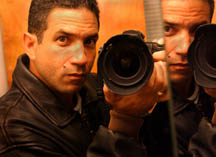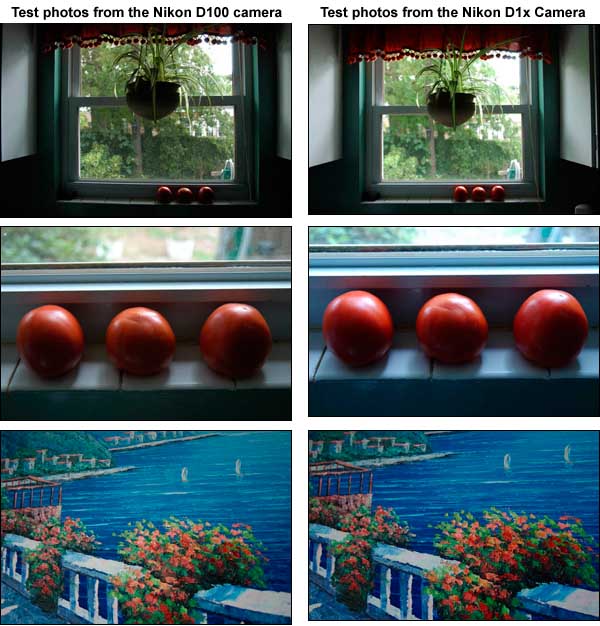Camera
Corner
Nikon D100 Review
By Roger Richards
|

|
The introduction
of the new D100 digital camera by Nikon is a welcome addition for those
who have been looking to go digital without spending thousands of dollars
for the line's top-end cameras. Nikon sent us a D100 at The Digital
Journalist and I was able to compare the camera to its more costly siblings.
 Readers
of The Digital Journalist might recall that I have been using Nikon
digital SLR's for a number of years now, from the NC2000E, the D1 and
then the D1X and D1H cameras. Each model introduction has taken digital
imaging further. At both the Virginian-Pilot in Norfolk and my former
employer, the Washington Times in DC, the digital SLR's were usually
employed only for situations where deadline pressures and/or remote
location logistics were a factor. The D1 was the solution to many problems. Readers
of The Digital Journalist might recall that I have been using Nikon
digital SLR's for a number of years now, from the NC2000E, the D1 and
then the D1X and D1H cameras. Each model introduction has taken digital
imaging further. At both the Virginian-Pilot in Norfolk and my former
employer, the Washington Times in DC, the digital SLR's were usually
employed only for situations where deadline pressures and/or remote
location logistics were a factor. The D1 was the solution to many problems.
At the Virginian-Pilot we took the plunge last year and the entire staff
was equipped with the new D1X cameras, with several D1H units as pool
cameras for sports coverage. The transition has been seamless, with
staffers who once were leery of going digital now passionate advocates
of the new technology. We have since been looking to add a couple of
other digital cameras that are not as costly as the D1X to our equipment
pool for occasions when a small camera with high-quality imaging is
needed.
This review of the D100 looks at the camera from the perspective of
a working photojournalist and so I am leaving out a lot of the technical
details as there are others who are much better at explaining these
aspects. For more tech info go
to Nikon's Web site.
The D100 has a large CCD producing a 6.1 megapixel image, up to 3008
x 2000 pixels, as compared to the D1H's 5.47 megapixel CCD. Here at
the Virginian-Pilot we normally shoot in the JPEG Normal mode, about
17.3 megabytes with the D100 (as compared to 16.9 megabytes with the
D1X). The image quality selector allows the choice of six options: NEF
(RAW), Comp. NEF (RAW), TIFF-RGB, JPEG-Fine, JPEG-Normal and JPEG-basic.
The camera is compatible with the 512MB and 1GB IBM MicroDrive compact
flash cards.
The camera will shoot up to three frames per second in continuous mode,
with six frames stored in the memory buffer, or four RAW images. What
this means is that you really do not want to use this camera to shoot
sports events. If you think the D1X is slow, it is a racehorse compared
to this camera. This is not what it was designed to do.
The D100 has many of the same features as Nikon's more professional
units, including custom menus where degrees of image sharpening can
be selected during exposure; color space settings for streamlined workflow
(sRGB and Adobe RGB); white balance presets and auto modes; and exposure
modes like aperture priority, shutter priority, program and manual.
Top shutter speed is 1/4000 second, and flash sync speed is 1/180 second.
A small built-in flash wide enough to cover a 20mm lens offers a handy
option for fill flash if one does not wish to carry an external unit.
The camera's ISO range is from 200 to 1600, with the option of then
selecting Hi-1 (ISO 3200) and Hi-2 (ISO 6400).
On the back of the D100, the monitor screen is a bit smaller than those
on the D1X or D1H cameras, and not quite as crisp, although it is still
quite good. It seems that Nikon has heard their customers as the new
screen has a clear high-impact plastic cover, better than the almost-opaque
soft cap on the D1X/D1H or the dark plastic that you had to remove to
view the D1's monitor. Hoodman will not be making any money from the
D100.
I shot a series of images with the D100 and the D1X for a comparison.
Both cameras were used in matrix metering, ISO 400, aperture priority,
auto white balance with a Nikon 17-35 f2.8 zoom. The images are exactly
as produced by the cameras with no Photoshop toning. The main difference
I found between the cameras was that the D1X was a bit more centerweighted
than the D100 even in matrix metering mode. To obtain a similar image
when shooting throught the window it was necessary to set the exposure
compensation dial
to 1 1/2 stops over on the D1X.

After using the
D100 for a bit I have come to several conclusions.
1. The D100 is not made to stand up to the rigors of daily photojournalism
use. The camera feels really good in the hand, built of high-impact
plastic over a metal base with a rubber covering. After using the D1X
and D1 on a daily basis for a while, and seeing how those cameras eventually
do get pretty banged-up, the D100 will most likely not fare as well.
Still, it would be a good choice for a second body as long as it is
not exposed to the elements too much or smacked around a lot. I definitely
would not carry this camera to Afghanistan as a primary camera.
2. The image quality is excellent when using good lenses and metering
is excellent.
3. Great camera for an entry level pro, advanced non-professional or
photography student.
4. I am really looking forward to the next generation of Nikon digital
cameras, hopefully with specs that say 'Foveon sensor inside'.
Roger Richards
Contributing Editor
roger@digitalfilmmaker.net
|

 Readers
of The Digital Journalist might recall that I have been using Nikon
digital SLR's for a number of years now, from the NC2000E, the D1 and
then the D1X and D1H cameras. Each model introduction has taken digital
imaging further. At both the Virginian-Pilot in Norfolk and my former
employer, the Washington Times in DC, the digital SLR's were usually
employed only for situations where deadline pressures and/or remote
location logistics were a factor. The D1 was the solution to many problems.
Readers
of The Digital Journalist might recall that I have been using Nikon
digital SLR's for a number of years now, from the NC2000E, the D1 and
then the D1X and D1H cameras. Each model introduction has taken digital
imaging further. At both the Virginian-Pilot in Norfolk and my former
employer, the Washington Times in DC, the digital SLR's were usually
employed only for situations where deadline pressures and/or remote
location logistics were a factor. The D1 was the solution to many problems.